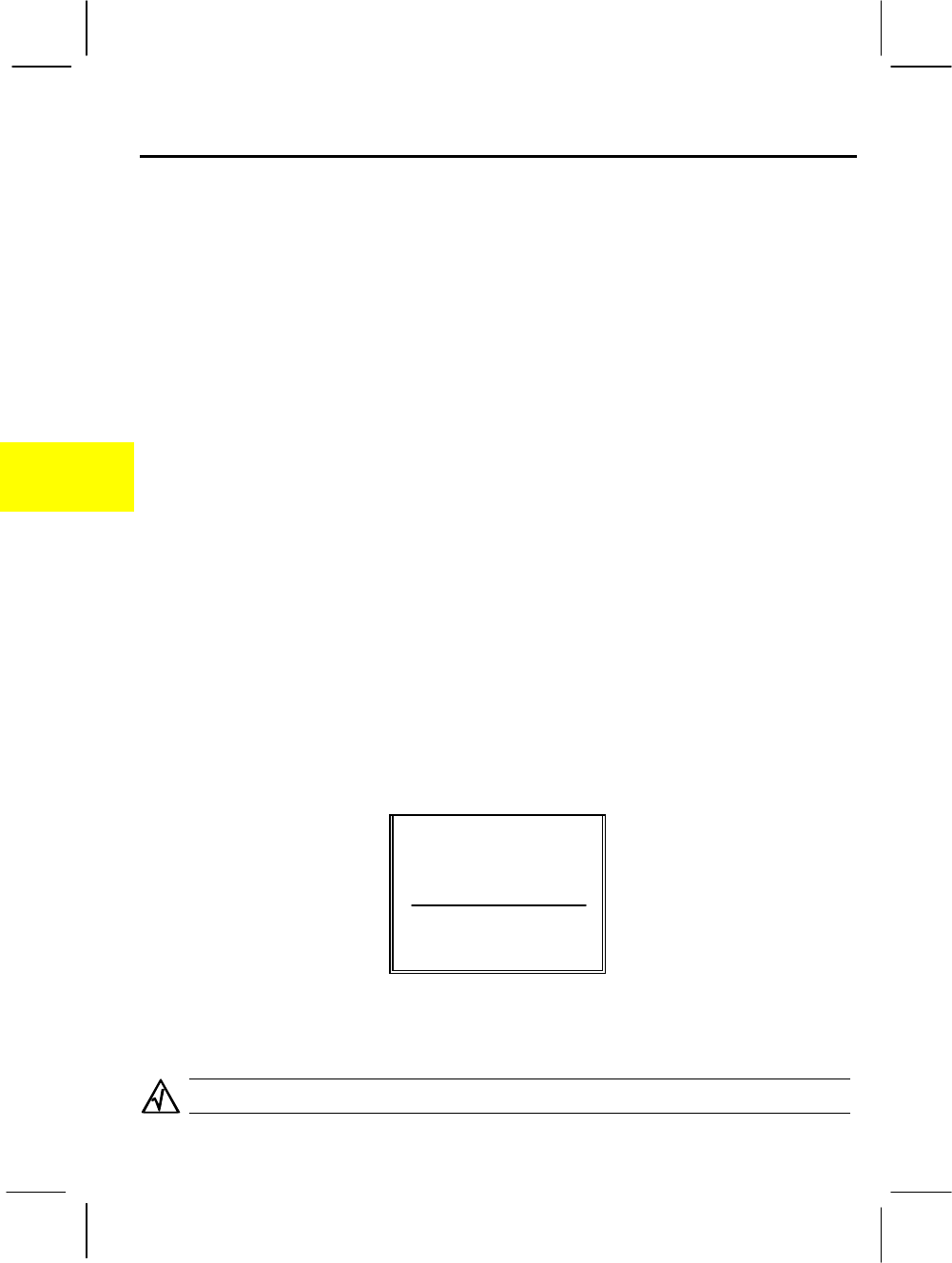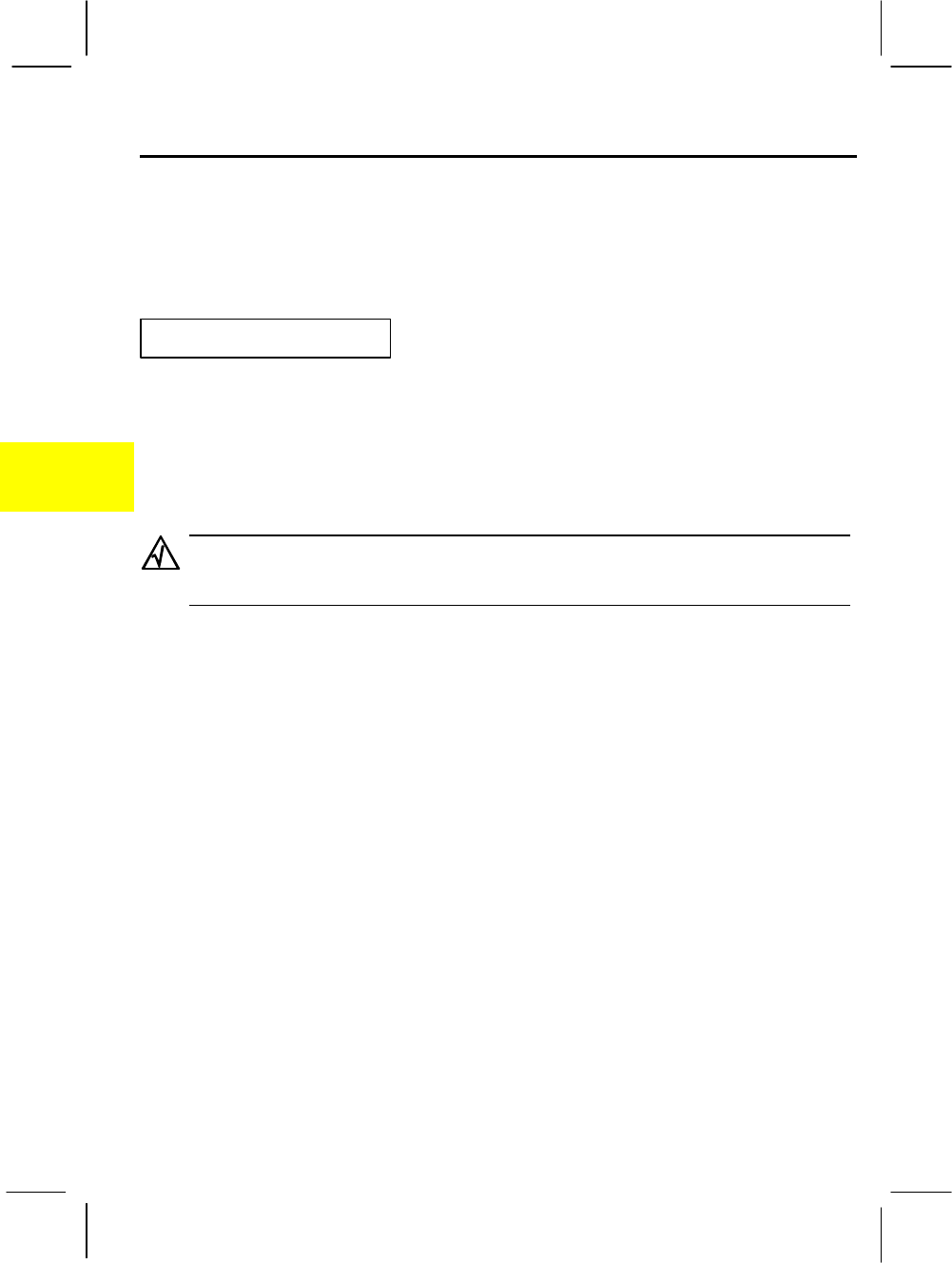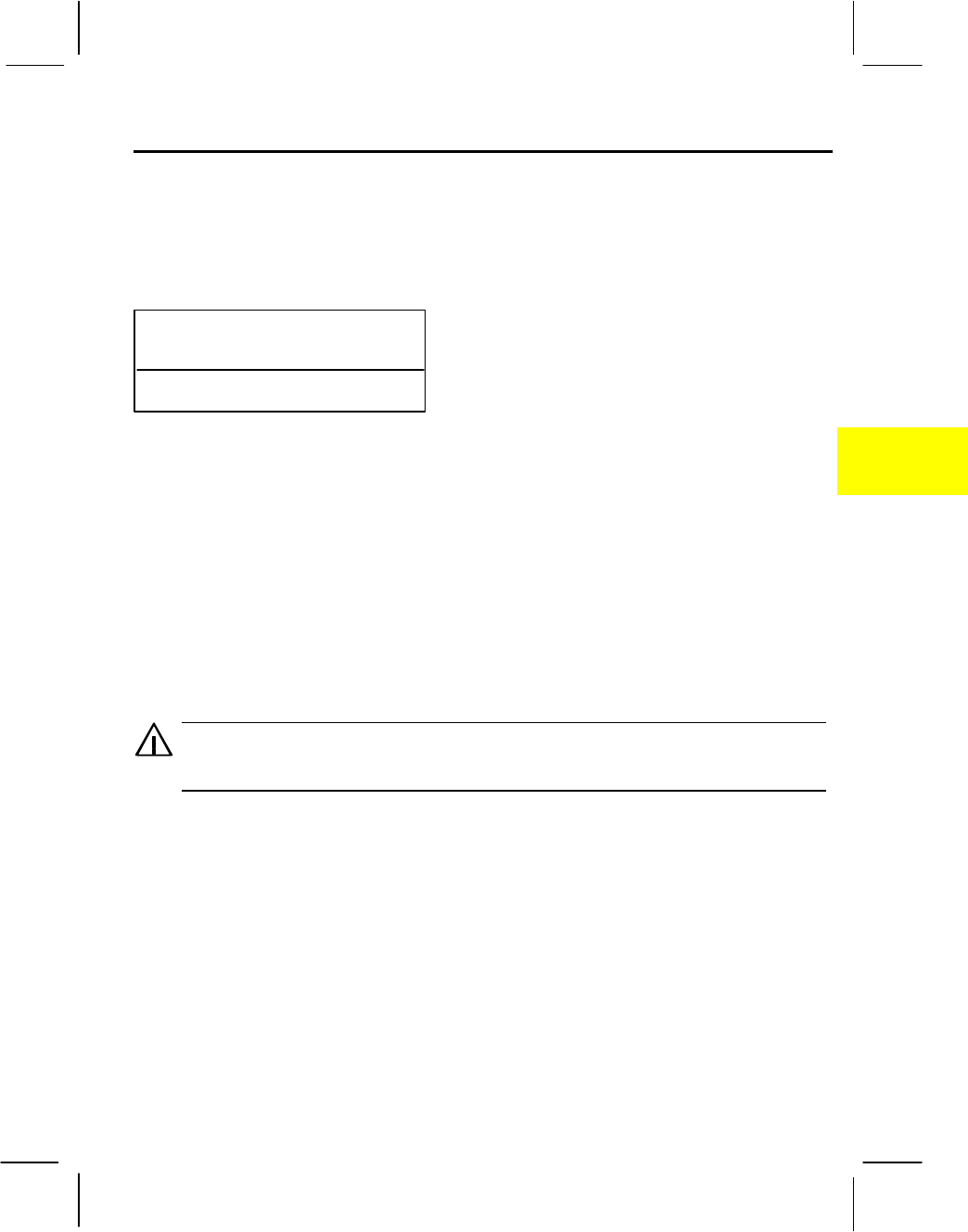InnoLabs I1000-PII Personal Computing Tablet User Manual ch5
InnoLabs Corporation Personal Computing Tablet ch5
InnoLabs >
Ch5

System Configuration Utility
This chapter tells you how to configure your system using the SCU (Setup
Configuration Utility).

5
Introduction
SCU is a program that allows you to enter system configuration information and
to store the information in CMOS (Complementary Metal Oxide Semiconductor)
RAM.. A RTC backup battery maintains CMOS RAM data so that
configuration information is not lost when the system is turned off.
A computer needs the configuration information to identify the type of devices
installed and to set up special features.
The configuration information has been set up with default settings in the factory.
You need to run SCU only when:
Error messages appear on the screen asking you to run SCU.
You want to change factory default settings.
You want to update the configuration information according to a new device
installed or an existing device removed.
Starting SCU
To run SCU, turn on or restart the system and press the [Space] bar when the
"System will Boot from C:, Press <Space> to change Boot Device or Run
Setup” message appears at the bottom of the screen. The boot menu as shown
below pops up.
Boot from FDD A:
Boot from HDD C:
Boot from CD-ROM
Run SCU Setup
<Enter> to Confirm
<Esc> to Cancel
Select the Run SCU Setup” item using the arrow key and then press [Enter] to
run SCU.
The SCU program is subject to change without notice. If the SCU program was

System Configuration Utilities 5-3
5
modified after this manual was printed, you will find discrepancies between this
chapter and the SCU program.

5
SCU Screen
Startup PowerManagement PassWord Device Features Utility Memory Exit
IDE Hard Drive : 2067 MB
IDE CDROM Drive: TOSHIBA CD-ROM
Secondary IDE : --
Serial Port 1 : 03F8h IRQ 04
SIR/FIR Port : 02F8h IRQ 11 DMA 00
Internal Modem : 03E8h IRQ 05
ECP/PIO Port : 0378h IRQ 07 DMA 07
Card Reader : 2 F8h IRQ 03
Touch Panel : 3 E8h IRQ 05
PCI Device 02 : 10D9 0531h LAN
PCI Device 03 : 104C AC16h PCMCIA
PCI Device 04 : 104C 8009h 1394
PCI Device 03 : 125D 1978h AUDIO
PCI Device 00A : 1023 939Ah VGA
Pentium-II CPU 300 Mhz
L2 Cache Size = 512 KB
Total DRAM Size= 32 MB
Bank 0 : SDRAM 32 MB
Bank 1 : None
Bank 2 : None
Bank 3 : None
Bank 4 : None
Bank 5 : None
Motherboard Rev. : 3
System BIOS Rev. : 0.19
Boot Block Rev. : 0.14
Keyboard BIOS Rev.: 2.00
Configure system startup options
<Cursor> key to select menu item
<Space> and <Enter> keys to toggle or activate menu item
The SCU screen consists of four areas:
Menu bar is at the top of the screen. It contains menu titles for different
categories. When a title is selected, a pull-down menu appears containing
setup items. A check mark (√) in front of an item indicates "Enabled” and
a hyphen (-) indicates "Disabled”.. When an item with no mark in front is
selected, a sub-menu will pop up.
Information area is the center area of the screen. This area displays the
system current configuration information. When a setup item is selected,
a sub-menu may appear in this area for you to make selections.
Help is below the center area. It provides an explanation of the selected
item.
Keyboard help is at the bottom of the screen. It gives keyboard
instructions for moving around and making selections.
Devices System

System Configuration Utilities 5-5
5

5
Entering the Information
You can use the keyboard to move around and make selections.
With the Keyboard
In general, use arrow keys to move around and press [Enter] to select.
To complete the selection, there are different keyboard operations under
different situations:
For an item containing no sub-menu, press [Space bar] to toggle between
enabled (√) and disabled (-).
In a sub-menu listing all the options, press the arrow key to move the bullet (l)
to your selection then press [Enter] to complete the selection.
In a sub-menu containing multiple setup items, press the arrow keys to move
to an item. Press the [Space bar] to pull down the list of options, use arrow
keys to select an option, and press [Enter] to complete the selection.
Alternatively, you can press [F5] or [F6] to cycle through the options
bypassing the pull-down menu.
You can also use the shortcut key highlighted by a different color on the screen.

System Configuration Utilities 5-7
5
Startup Menu
The Startup pull-down menu allows you to select settings relevant to startup
operation.
Startup
Date and Time
Boot Device
√
Enable Fast Boot
- Keyboard Numlock
- Virus Alert
- Disable VGA Expansion
All items on this menu are described in the sequence below.
Date and Time
Sets the system date and time (24-hour format).
Boot Device
Specifies the device from which the system searches the operating system. The
choices are Diskette A, Hard Disk C, and CD-ROM Drive.
Enable Fast Boot
Sets if the memory test is skipped during POST. If this item is enabled, the
booting time can be shortened.
Keyboard Numlock
Sets if the Num Lock is automatically turned on for the internal keyboard after
system startup.
Virus Alert
Sets if the warning messages announce that the hard disk boot sector (partition
table) has been changed.
Disable VGA Expansion
VGA expansion can expand low resolution mode to full panel range. If disable
expansion, you will see small display if resolution is not 1024x768.

5
PowerManagement Menu
The PowerManagement pull-down menu allows you to set up Power
Management features.
PowerManagement
- Enable Video Time-Out
- Enable Ring resume
- Enable Battery Low Beep
- Enable TV
- Enable Capture
- Enable ZV Port
- APM Suspend Select
- Power Button Function
- Battery Fail Process
All items on this menu are described in the sequence below.
Enable Ring Resume
Sets if the system resumes from low power mode (Global Standby, Power-
On-Suspend, or Suspend-to-Disk) when the modem receives an incoming call.

System Configuration Utilities 5-9
5
PassWord Menu
The PassWord pull-down menu allows you to create passwords to protect your
computer against unauthorized use.
PassWord
Edit New Password
- Enable Boot Security
- Enable SCU Security
All items on this menu are described in the sequence below.
Edit New Password
Sets the password for starting up the system, running the SCU program,
unlocking Quick Lock, or using the hard disk drive. When setting a password,
first make sure that Num Lock is off, then type your password and press [Enter].
Confirm your password by typing it again and pressing [Enter].
Remembering the password is essential.
Enable Boot Security
Sets if the system asks for the password before starting up.
Enable SCU Security
Sets if the system asks for the password before running the SCU program.

5
Device Menu
The Device pull-down menu allows you to select settings relevant to system
devices.
Device
- Disable
- Disable Card Reader
- Disable COM Port
___________________
IDE/HDD Performance
Select PIO Mode
-
All items on this menu are described in the sequence below.
Disable IR
IRQ resouces are very limited. UART2 occupies 8 consecutive ports and an
IRQ. If no free IRQ is left for PCMCIA card, and IR is not used, user can
disable IR.
IDE/HDD Performance
This allows users to set HDD transfer speed. There are three speeds :
Maximum/Medium/Compatible speeds. BIOS will detect HDD maximum speed
and set it if users want high performance. But users have to know that some
HDDs can not accept this highest speed. It’s better to select Medium speed for
this case.
Select PIO Mode
There is four modes: SPP/PS2/EPP/ECP modes. SPP is the old standard and is
the most compatible mode.
Select MODEM Port
If user plugs in Internal Modem, he can select the modem port here.

System Configuration Utilities 5-11
5
Features Menu
The Features pull-down menu allows you to set up several system features.
Features
Set TV Mode
Keyboard Repeat
Keyboard Matrix
All items on this menu are described in the sequence below.
Set TV Mode
Sets the TV mode when a TV is used for the display output. Select PAL for use
in the UK and Europe; NTSC for use in other areas.
Keyboard Repeat
Invokes a sub-menu that lets you set up "Keyboard Repeat” function.
"Keyboard repeat” means that continually holding down a key on the keyboard
is interpreted as repeatedly pressing the key. The sub-menu contains the
following items:
Keyboard Repeat Rate Sets the rate (in characters/second) at which the
keys are repeated.
Key Delay sets the delay (in seconds) between when the key was first
pressed and when the repeating begins.

5
Utility Menu
The Utility pull-down menu provides a function that verifies the suspend-to-disk
partition.
Utility
Verify S2D Partition
Verify S2D Partition
Checks the suspend-to-disk partition for any defect block. You may use this
function once in a while to make sure that defect blocks in the suspend-to-disk
partition are not used to store data.
This function also backs up the BIOS ROM data to the suspend-to-disk partition. This
is helpful when the BIOS ROM happens to fail. With the backup data, the computer
can still boot using the BIOS ROM data in the suspend-to-disk partition.

System Configuration Utilities 5-13
5
Memory Menu
The Memory pull-down menu allows you to set up shadow RAM and system
memory configuration.
Memory
√
BIOS Shadow RAM Cacheable
√
VGA Shadow RAM Cacheable
Setup EDO/SDRAM Timing
All items on this menu are described in the sequence below.
BIOS Shadow RAM Cacheable
Sets if the system BIOS is copied to RAM to increase the BIOS speed.
VGA Shadow RAM Cacheable
Sets if the video BIOS is copied to RAM to increase the video speed.
Setup EDO/SDRAM Timing
Invokes a sub-menu that lets you set up specific information of the RAM
installed in your computer. It contains the following items:
Never alter these items by yourself. Leave these items to your dealer, who knows the
specifications of the RAM installed in your computer. The computer may malfunction
if you set the items to incorrect values.
EDO DRAM Read Burst Timing
Sets the read burst timing according to the EDO DRAM installed in your
computer.
EDO DRAM Write Burst Timing
Sets the write burst timing according to the EDO DRAM installed in your
computer.
Select SDRAM CAS Latency
Sets the CAS latency according to the SDRAM installed in your computer.

5
Exit Menu
The Exit pull-down menu provides ways of exiting SCU. When you are finished
with the settings, save and exit SCU so that the new settings can take effect.
Exit
Save and Reboot
Exit (No Save)
Default Settings
Restore Settings
Save and Reboot
Saves changes you have made and reboots the system.
Exit (No Save)
Exits without saving the changes you have made.
Default Settings
Loads factory default settings for all the items.
Restore Settings
Restores previous settings for all the items.